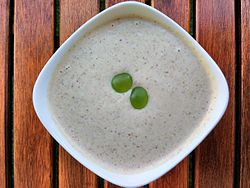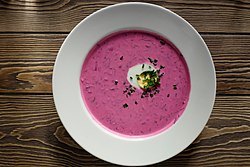| Name | Image | Origin country | Summary description |
|---|
| Ajoblanco |  | Spain | Spanish cold soup typical from Granada and Málaga (Andalusia). It is also a common dish in Extremadura (Ajo Blanco Extremeño).[1] This dish is made of bread, crushed almonds, garlic, water, olive oil, salt and sometimes vinegar |
| Avocado soup |  | | Can be prepared and served as a cold or hot soup |
| Cold borscht |  | Slav and Baltic nations | Made from beetroot with optional onions, garlic, carrot, celery parsnip etc; with a base of sour cream, buttermilk, kefir, kvass, or yogurt. May be served with boiled potato or egg. National varieties include svekolnik, kholodnik, šaltibarščiai. |
| Fruit soup |  | | Soup prepared using fruit as a primary ingredient. Pictured is Chinese fruit soup. Some fruit soups are also served warm or hot. |
| Gazpacho |  | Spain | In Andalusia, most gazpacho recipes typically include stale bread, tomato, cucumber, bell pepper, onion and garlic, olive oil, wine vinegar, water, and salt. |
| Naengmyeon |  | Korea | Cold noodle soup in cold meat broth |
| Naengguk |  | Korea | Refers to all kinds of cold guk (soups) in Korean cuisine, mainly eaten in summer. It is so called changuk, which literally means "cold soup" in pure Korean, while the term naengguk is a combination of a hanja word and a pure Korean word with the same meaning. |
| Okroshka |  | Russia | A mix of mostly raw vegetables (like cucumbers, radishes and spring onions), boiled potatoes, eggs, and a cooked meat such as beef, veal, sausages, or ham with kvass, which is a non-alcoholic (1.5% or less) beverage made from fermented black or rye bread. |
| Salmorejo |  | Spain | Salmorejo is a purée consisting of tomato and bread, originating from Cordoba in Andalucia, south Spain. It is made from tomatoes, bread, oil, garlic and vinegar. The purée is served cold and may be garnished with diced Spanish serrano ham and diced hard-boiled eggs. |
| Sorrel soup |  | Eastern Europe | Also known as shchav, green borscht or green shchi. The cold version is made from water, sorrel leaves, and salt. Varieties of the same soup include spinach, garden orache, chard, nettle, and occasionally dandelion, goutweed or ramsons, together with or instead of sorrel. It may include further ingredients such as egg yolks or whole eggs, potatoes, carrots, parsley root, and rice. |
| Swedish fruit soup |  | Sweden | Typically prepared using dried fruits, and typically served as a dessert dish. It may be served hot or cold. [1] |
| Tarator |  | Bulgaria, Macedonia, Serbia, Greece, Turkey, Balkans | Tarator, tarathor, taratur, or ttalattouri is a soup, appetizer, or sauce found in the cuisines of Eastern Europe. It generally includes ground walnuts, garlic, and yogurt or tahini, and often cucumber, herbs, and vinegar or lemon juice. |
| Vichyssoise |  | France | Vichyssoise is a purée of leeks, onions, potatoes, cream and chicken stock. It is served cold. |













